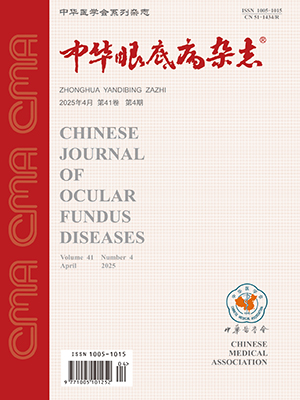| 1. |
Davidorf FH, Pressman MD, Chambers RB. Juxtafoveal telangiectasis-a name change?[J]. Retina, 2004, 24(3): 474-478. DOI: 10.1097/00006982-200406000-00028.
|
| 2. |
Gass JD, Oyakawa RT. Idiopathic juxtafoveolar retinal telangiectasis[J]. Arch Ophthalmol, 1982, 100(5): 769-780. DOI: 10.1001/archopht.1982.01030030773010.
|
| 3. |
Gass JD, Blodj BA. Idiopathic juxtafoveolar retinal telangiectasis. Update of classification and follow-up study[J]. Ophthalmology, 1993, 100(10): 1536-1546. DOI: 10.1016/S0161-6420(93)31447-8.
|
| 4. |
Yannuzzi LA, Bardal AM, Frund KB, et al. Idiopathic macular telangietasia[J]. Arch Ophthalmol, 2006, 124(4): 450-460. DOI: 10.1001/archopht.124.4.450.
|
| 5. |
Spaide RF, Klancnik JM, Cooney MJ. Retinal vascular layers in macular telangiectasia type 2 imaged by optical coherence tomographic angiography[J]. JAMA Ophthalmol, 2015, 133(1): 66-73. DOI: 10.1001/jamaophthalmol.2014.3950.
|
| 6. |
Chidambara L, Gadde SG, Yadav NK, et al. Characteristics and quantification of vascular changes in macular telangiectasia type 2 on optical coherence tomography angiography[J]. Br J Ophthalmol, 2016, 100(11): 1482-1488. DOI: 10.1136/bjophthalmol-2015-307941.
|
| 7. |
吉宇莹, 张雄泽, 李妙玲, 等. 2型黄斑毛细血管扩张症眼底及影像特征观察[J]. 中华眼底病杂志, 2016, 32(4): 382-386. DOI: 10.3760/cma.j.issn.1005-1015.2016.04.009.Ji YY, Zhang XZ, Li ML, et al. Characteristics of fundus image in macular telangiectasia type 2[J]. Chin J Ocul Fundus Dis, 2016, 32(4): 382-386. DOI: 10.3760/cma.j.issn.1005-1015.2016.04.009.
|
| 8. |
才艺, 石璇, 赵明威, 等. 特发性黄斑视网膜血管扩张症2型的临床特点及诊断治疗研究进展[J]. 中华眼科杂志, 2019, 55(1): 68-72. DOI: 10.3760/cma.j.issn.0412-4081.2019.01.017.Cai Y, Shi X, Zhao MW, et al. Characteristics, multimodality imaging and treatment of macular telangiectasia type 2[J]. Chin J Ocul Fundus Dis, 2019, 55(1): 68-72. DOI: 10.3760/cma.j.issn.0412-4081.2019.01.017.
|
| 9. |
Charbel Issa P, Gillies MC, Chew EY, et al. Macular telangiectasia type 2[J]. Prog Retin Eye Res, 2013, 34: 49-77. DOI: 10.1016/j.preteyeres.2012.11.002.
|
| 10. |
Gillies MC, Zhu M, Chew E, et al. Familial asymptomatic macular telangiectasia type 2[J]. Ophthalmology, 2009, 116(12): 2422-2429. DOI: 10.1016/j.ophtha.2009.05.010.
|
| 11. |
胡立影, 李志清, 于荣国, 等. 特发性黄斑毛细血管扩张症的研究现状与进展[J]. 中华眼底病杂志, 2016, 32(4): 440-444. DOI: 10.3760/cma.j.issn.1005-1015.2016.04.026.Hu LY, Li ZQ, Yu RG, et al. The status and progress of studies of idiopathic parafoveal telangiectasis[J]. Chin J Ocul Fundus Dis, 2016, 32(4): 440-444. DOI: 10.3760/cma.j.issn.1005-1015.2016.04.026.
|
| 12. |
毛蕾, 宫媛媛. 特发性旁中心凹毛细血管扩张症诊治进展[J]. 中华眼视光学与视觉科学杂志, 2016, 18(6): 377-380. DOI: 10.3760/cma.j.issn.1674-845X.2016.06.012.Mao L, Gong YY. The development of the diagnosis and treatment of parafoveal telangiectasis[J]. Chin J Optom Ophthalmol Vis Sci, 2016, 18(6): 377-380. DOI: 10.3760/cma.j.issn.1674-845X.2016.06.012.
|
| 13. |
Spaide RF, Klancnik JM, Cooney MJ, et al. Volume-rendering optical coherence tomography angiography of macular telangiectasia type 2[J]. Ophthalmology, 2015, 122(11): 2261-2269. DOI: 10.1016/j.ophtha.2015.07.025.
|
| 14. |
刘乘熙, 丁小燕. 2型黄斑毛细血管扩张症研究进展[J]. 中华实验眼科杂志, 2018, 36(8): 653-656. DOI: 10.3760/cma.j.issn.1005-1015.2018.08.016.Liu CX, Ding XY. The research progress of macular telangiectasia type 2[J]. Chin J Exp Ophthalmol, 2018, 36(8): 653-656. DOI: 10.3760/cma.j.issn.1005-1015.2018.08.016.
|




